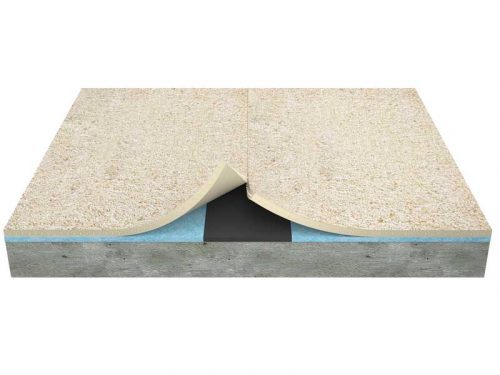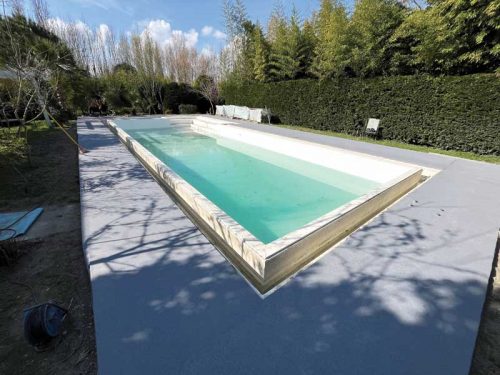By Matthew Sands
As pool professionals continue to look at different coatings options for pool interiors to offer clients, they are also looking for new options for the surrounding deck area of the pool. This is particularly important for pool renovations, which appear to be on the rise as the economy begins to cool.
Once pool professionals upgrade the interior of the pool, to complete the renovation, the deck must also accompany the esthetics. This is where a polyvinyl chloride (PVC) pool deck membrane becomes an attractive solution. By using similar techniques used to cover the interior of the pool, installers can also use a PVC pool deck membrane to renovate the surrounding deck as it is ideal for use both indoors and outdoors.
Renovation benefits of PVC pool deck membrane
The use of concrete, stamped concrete, tiles, and flagstone have traditionally been the primary choices for surrounding pool and spa decks. However, once these surfaces become worn out and cracked, pool owners seek ways to renovate these decks.
Pool professionals should consider adding PVC pool deck membranes to their offering because it provides a long-lasting waterproof solution that does not require recoating and comes with far less maintenance than traditional decking solutions. Unlike concrete decks, PVC membranes for pool and spa decks can be installed in almost any temperature. In fact, the PVC membrane eliminates the common cracking problems in concrete that occur with freeze-thaw weather.
Additionally, installation of the PVC pool deck is more efficient than traditional decking materials. Pool installers will also benefit from the shorter installation times to maximize the number of jobs they can do in a season without waiting for subcontractors or drying concrete. PVC membrane decking can be installed on concrete surfaces, tiled floors, or wood.
Reinforced PVC also offers additional safety benefits for decks experiencing cracking, flaking, delamination, and peeling which can particularly be appealing for commercial aquatic facilities. In some cases, the decks around pools can be the most dangerous part of any pool. Older, cracked, or peeling decks can lead to injuries due to slippery surfaces. Some cracks can even cut bathers’ feet. Reinforced PVC encapsulates the deck, making the area slip-resistant and waterproof.

Having a fully waterproofed deck has many advantages, including long-term structural advantages. For example, if the pool deck is not properly waterproofed, the water left by swimmers exiting the pool or splash-out or deck cleaning can penetrate the floor and infiltrate the substrate causing future maintenance issues to the structure. This risk is frequently underestimated by construction companies. Water on the deck that does not drain properly, over time can infiltrate the structure and deteriorate the pool, not to mention being visually detracting and unsafe. Using reinforced PVC to waterproof the entire deck avoids all this because it guarantees complete waterproofing of the deck. When combined with a compatible gutter system, it ensures a seamless waterproofing from the pool to the deck. Further, the slip-resistant PVC ensures all safety requirements in all areas of the wet-zone are met.




PVC deck membrane installation
If installed over existing concrete, the installation requires the following steps:
- Filling any cracks or holes in the surface
- Levelling and cleaning the surface
- Applying glue
- Applying an antimicrobial felt/geotextile layer
- Laying down and welding together the reinforced PVC
Both residential pool customers and commercial aquatic facilities also benefit from the shorter installation time required; the only downtime is if the surface requires levelling, in which case, a levelling material is poured prior to the installation of the reinforced PVC. The installation time is similar to welding the interior of a pool. For instance, a 6.1 x 6.1 m (20 x 20 ft) area can be lined and welded in a few hours when using a robotic welder.
Similar to the installation of reinforced PVC on pool interiors, reinforced PVC for pool decks is also rolled out and heat-welded together on-site to ensure an accurate, smooth fit to the shape of the deck that is completely jointless. The process does require some skill, but many suppliers provide on-site training and initial installation assistance to pool professionals who are just getting started. Once trained, reinforced PVC can be installed year-round on indoor pools and even in cooler climates, such as late fall and early spring.
Deck preparation
It is essential to carry out a thorough clean of the entire surface, as well as of the pool area. It is important to remember the reinforced PVC membrane will replicate the shape of any imperfection or impurity. For this reason, and given the decking area is usually large, it is recommended to use an industrial vacuum cleaner, to remove both solid and liquid waste. Several extensive cleans will be carried out after each stage prior to the membrane application.
Geotextile application
The geotextile layer has the dual function of filling the step generated by the butt-welding strip, and of attenuating eventual irregularities in the underlying floor. If the existing floor should have strong irregularities, it is recommended to provide for prior repairs.
Before applying the floor adhesive, the surface must be thoroughly cleaned again, removing any debris from the leveller and other impurities that can cause both esthetic and adhesion problems. Once the pavement is levelled and free of impurities, pavement adhesive is applied.
The antimicrobial felt/geotextile layer is glued to the floor, making sure it coincides perfectly with the butt-welding strip, taking good care of not overlapping it, or leaving any space between.
Cutting and welding membrane into place
The reinforced PVC pool interior is rolled out in 1.65 m (5.4 ft) wide lengths, cut to the dimensions of the pool deck, and then heat-welded together on-site to ensure a smooth fit. Since decks require a completely smooth finish, installers use what is commonly known as a ‘butt-welding’ technique. To do this, installers butt the reinforced PVC edges against one another, rather than overlapping them. This creates a completely smooth decking surface.

Safety and maintenance benefits
The decks around swimming pools can often be the most dangerous part of the pool. Older, cracked, or peeling decks cause injury from slippery surfaces, and cut feet from cracks. The PVC membrane encapsulates and makes the deck area slip-resistant and waterproof. This option is ideal for decks experiencing cracking, flaking, de-lamination, and peeling.
PVC deck membrane material is very resistant to chlorine and stains, thanks to its highly protective acrylic lacquer coating. The membrane’s smooth surface prevents the accumulation of dirt and grime—reducing the need for frequent cleaning and maintenance. Unlike other decking products, there is no need to use acid or other dangerous and abrasive cleaners to keep the surface in perfect condition all year long. This is a great selling point for homeowners and is especially appealing to commercial aquatic facilities.
The PVC deck membrane offers a commercial grade, long-term solution because it is not only thick and non-porous but also coated with a protective lacquer that resists chemical abuse, water absorption, and UV deterioration.
Additionally, once the reinforced PVC is installed, the surface underneath the pool deck can continue to shift and crack but it will not affect the reinforced PVC pool interior itself. Further, in many cases, this reinforced PVC deck membrane often comes with a longer warranty than other deck options. In many cases, not only does the reinforced PVC interior pool finish help to solve a deck problem, but it can also make pool maintenance easier than a traditional concrete deck surface.
Reinforced PVC is a practical solution for pool interiors because it can be applied over most existing pool shells to renovate deteriorated pools or to quickly provide an interior finish for new pools. In fact, the installation of reinforced PVC can even be done over cold joints in concrete and is not susceptible to freeze-thaw cycles. The PVC deck membrane also stabilizes the pool deck by preventing future water infiltrations. The reinforced PVC can also be easily combined with gutter-system to create a seamless watertight solution for the entire pool area.
Adding PVC pool deck membrane option
The installation process of a PVC deck membrane does require some skill, but many suppliers now provide onsite training and initial installation assistance to pool professionals getting started. Once trained in PVC pool deck membrane installation, the product can be installed year-round on indoor pools and even in many cooler climates into the late fall and early spring.
PVC deck membranes can be a great profit centre for larger service companies looking to expand their service offerings. This attractive, quick-installation, and long-lasting decking renovation solution is a terrific option for pool professionals to start offering around in both residential and commercial pools and spas, as well as locker rooms, patio decks, hallways, and more. Due of its commercial grade slip-resistance and fire-resistance properties, this product can truly renovate and floor surface.
Author
Matthew Sands has more than a decade of successful experience in the construction renovation sector of Renolit, having worked for one of the most well-known European flooring brands. Sands has been overseeing the renovation of several major projects including La Fenice Opera House in Venice, Italy, and LAC Cultural Center in Switzerland. He can be reached at [email protected].
The post Seamless solutions: PVC reshaping pool decks appeared first on Pool & Spa Marketing.






